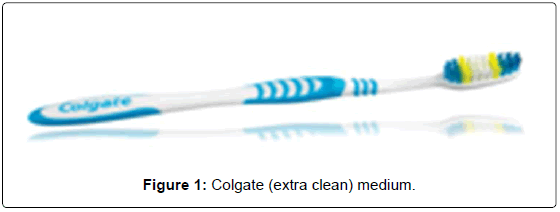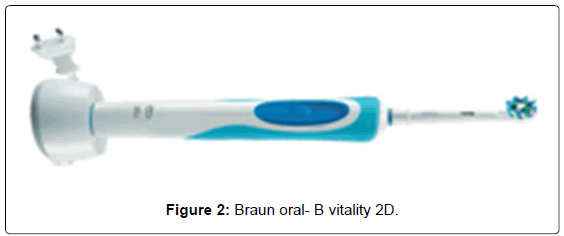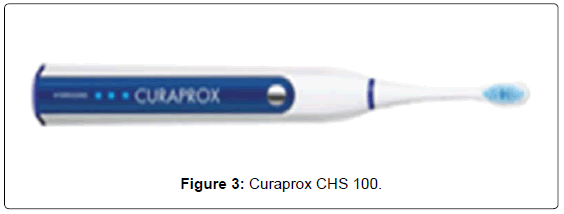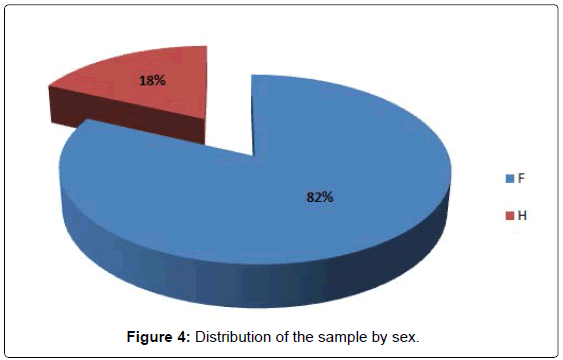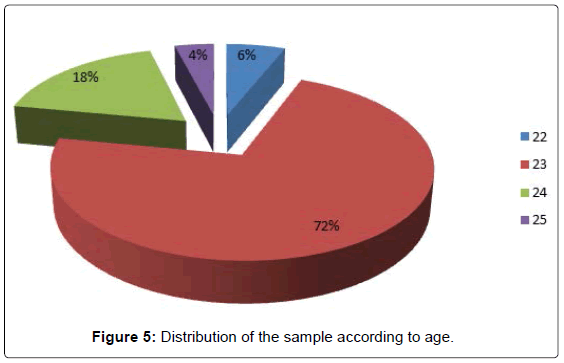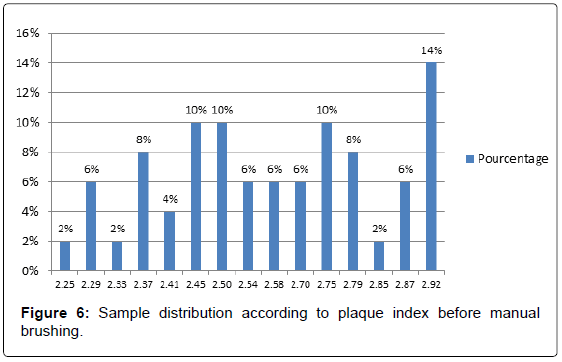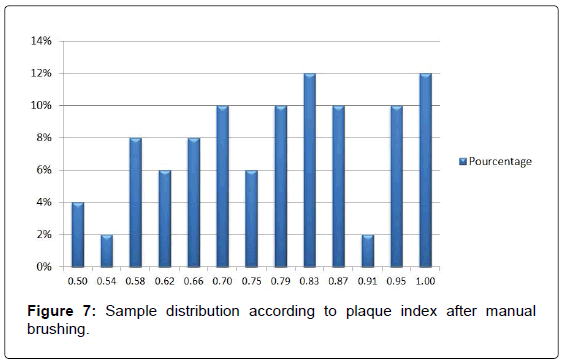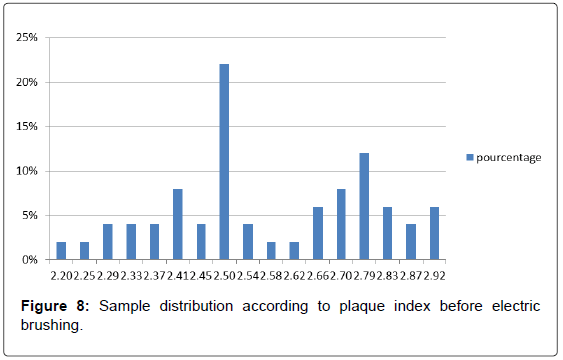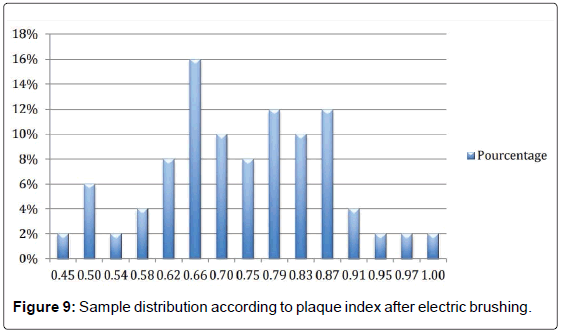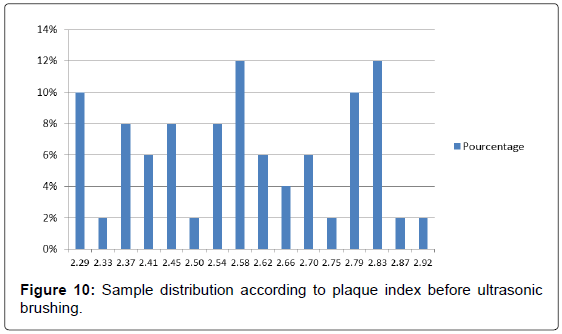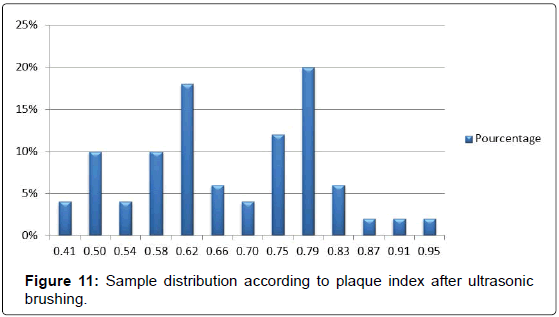A Single-Brushing Study to Compare Plaque Removal Efficacy of a Manual Toothbrush, an Electric Toothbrush and an Ultrasonic Toothbrush
Received: 12-Oct-2018 / Accepted Date: 14-Nov-2018 / Published Date: 23-Nov-2018 DOI: 10.4172/2332-0702.1000249
Abstract
Introduction: The purpose of this study is to compare the effectiveness of the manual toothbrush, the electric toothbrush and the ultrasonic toothbrush, in the removal of dental plaque in dental students.
Materials and Methods: It is a comparative cross-sectional epidemiological study. 50 students in the 5th year of the dental school of Casablanca were selected to participate in this study. All subjects had to be in good general health and had complete dentition without malocclusions. They were required to stop oral hygiene for 12 hours and any food or beverage consumption for 4 hours before each of the three appointments during which the plaque index was recorded before and after the brushing with the toothbrush attributed tooth that day. The brushing time was 3 min for manual brushing, and 2 min for electric and ultrasonic brushing.
Results: In our study all toothbrushes significantly reduced plaque index after brushing:
A very significant difference between the reduction in the average plaque index obtained after manual brushing and that obtained after ultrasonic brushing in favor of the ultrasonic toothbrush. (p=0.0003)
An insignificant difference between the reduction of the average Plaque Index obtained after manual brushing and that obtained after electric brushing in favor of the electric toothbrush. (p=0.0982)
An insignificant difference between the reduction in the Plaque Index average obtained after electric brushing and that obtained after ultrasonic brushing in favor of the ultrasonic toothbrush. (p=0.0922)
Conclusion: The three toothbrushes managed to reduce the amount of plaque after brushing. The ultrasonic toothbrush is significantly better than the manual toothbrush in removing the plaque.
Keywords: Manual toothbrush; Electric toothbrush; Ultrasonic toothbrush; Comparative study;Dental plaque control
Introduction
Bacteria present in dental plaque are the main cause of caries, gum disease, and periodontal disease. Therefore, the prevention and treatment of these diseases necessarily require the removal of plaque [1]. In 1965 Löe et al. have demonstrated that there is a relationship between plaque accumulation and inflammation of gingival tissues. Löe in 1981 proved that rigorous oral hygiene at home combined with professional cleaning and/or the use of antimicrobial components can control the appearance of oral bacterial plaque. Thus, it can be concluded that a rigorous and regular oral hygiene is necessary to a good oral health.
Although there are various ways of removing plaque, including mechanical and chemical, the use of the toothbrush is the most effective and most used method, but its efficacy is relative to several parameters such as the type of toothbrush, method of brushing, ideal time to brush, as well as it’s used or not with adjuvant such as dental floss and/ or mouthwashes [2].
The introduction of the plastic-handled, nylon-bristled toothbrush on the market in the 1930s was without a doubt one of the greatest advances in oral hygiene. Since then, the manual toothbrush has become the mainstay of the practice of oral hygiene in developed countries [3].
The miniaturization of electrical appliances enabled Bergman and Woog in 1952 to invent the first electric toothbrush, however, its commercialization did not take place until 1960 under the name of Broxodent. This toothbrush made oscillations movements with large amplitude (from 18 to 23 mm) and with a frequency of oscillations between 40 and 70 Hz. It consequently made it possible to eliminate the manual fatigue, but to obtain a brushing as effective as with a manual toothbrush, it was necessary to increase the time of brushing.
What made it a technological “gadget” more than a real tool of oral hygiene? Technologies continued to evolve and other systems were invented to improve the elimination of plaque.
Currently, the existing powered systems can be classified into two main families:
- Rotating systems with rotary brushing, oscillo-rotary (2D technology) and pulsating oscillo-rotary brushing (3D technology).
- Systems with sonic movements.
The effectiveness of toothbrushes varies considerably from one model to another, considering the wide choice presented to patients, they often struggle to get the most suitable toothbrush for good oral hygiene. Therefore, we conducted this study in order to compare the ability of plaque removal of three different technology toothbrushes, namely, the manual toothbrush, the electric toothbrush with oscillating-rotary movement and the ultrasonic toothbrush in dental students’ population [4].
Materials and Methods
A comparative clinical study is conducted in the fixed Prosthodontics Department of Ibn Rochd Hospital in Casablanca between October and December 2017 by two dental students as part of their thesis for obtaining a doctorate in dentistry.
Fifty students in the 5th year of the Faculty of Dentistry of Casablanca were included in the study. Sampling was done using the software EPI INFO 6 version 6.04. Students met the following inclusion criteria:
• 5th year students of the faculty of dentistry of Casablanca.
• Good general state of health.
• Full dentition (not including third molars).
• Absence of malocclusions.
• Can brush their teeth themselves.
• Verbal informed consent.
The exclusion criteria are:
• Students with periodontal disease.
• Students in post-surgical healing period.
• Students with pain syndrome.
• Pregnant students.
• Students undergoing fixed orthodontic treatment.
• The material used to conduct this comparative study is composed of:
• Manual toothbrush: Colgate * Extra Clean* medium (Figure 1).
• Electric Toothbrush: Braun Oral-B vitality 2D: The round heads are animated with partial and fast rotations up to 7600 rotationsoscillations/ min in both clockwise and counterclockwise directions (Figure 2).
• Ultrasonic toothbrush: Curaprox CHS 100: it has 3 modes (soft, intensive and massage) established according to the speed of vibrations which can go from 32.000 to 42.000 oscillations, in our study we used the mode “soft” and a head with strands flexible CHS 200 which is composed of strands short and long strands (Figure 3).
• Colgate Cavity Protection Toothpaste
• Examination tray comprising a dental mirror and a periodontal probe.
The data collection was done using survey sheets with two separate parts, the first part being a questionnaire on the name, age and sex of the student. While the second part contains 3 tables corresponding respectively to manual, electrical, ultrasonic brushing. Each table contains 2 columns showing pre-brushing and post-brushing plaque index.
The plaque has been demonstrated by the Löe and Silness plaque index, which makes it possible to assess the amount of bacterial plaque in contact with the gingival fibro-mucosa.
This index is calculated on the faces Vestibular, Lingual, Distal and Mesial, of the 12, 16, 24, 32, 36 and 44 according to 4 scores:
0: absence of bacterial plaque.
1: film of bacterial plaque detected by the probe, invisible to the naked eye.
2: moderate deposit, visible to the naked eye.
3: significant accumulation.
A pre-survey was conducted on eight students in advance to calibrate the investigators for the standardization of materials and methods of the study and to test the constraints of the established protocol and to verify its feasibility and also to detect the subsequent difficulties during the study investigation. Thus, the realization of this pre-investigation enabled us to validate the protocol as it was previously established without any modification. The 8 students were not included in the study itself.
After checking the eligibility of the subjects, we started by explaining the interest of the work and inform them of the progress of the study and then we obtained their verbal consent. The subjects are informed that they should stop all the measures of oral hygiene for 12 hours and the consumption of food or drinks for 4 hours before each appointment.
During the first appointment, the interviewer starts by calculating the plaque index before brushing, then the student brushes his teeth for 3 min with the manual toothbrush, then the same investigator is responsible for calculating the plaque index after brushing. This protocol is repeated during the two appointments that follow, only, the toothbrush used changes, so students brush with the electric toothbrush at the second appointment and then with the ultrasonic toothbrush at the third appointment for 2 minutes according to the manufacturer’s instructions.
The brushing method recommended to students is to brush each arch separately. The manual brushing is done according to the modified Bass method starting with the vestibular faces, then the lingual faces and finally the occlusal faces of the teeth. In buccal and lingual teeth, the strands of the brush should be inclined towards the gum at an angle of 45° to the axis of the tooth. Occlusal movement is performed 2-3 times per tooth to remove plaque. For ease in the palatal and lingual surfaces of the anterior teeth, the brush is placed vertically and a movement in the occlusal direction is performed 2 to 3 times, and finally circular movements are performed at the occlusal surfaces.
For the electric brushing, we start with the vestibular faces then the lingual faces and finally the occlusal faces, the head of the brush must be guided from one tooth to another following the shape of each tooth and the curve of the gums without exert pressure, the strands should be perpendicular to the tooth surface. The brushing time is 2 minutes or 30 seconds per half-arcade.
For ultrasonic brushing, the time and method of brushing are similar to electric brushing, except that the toothbrush strands are oriented at 45° to the tooth axis in the gingival direction.
Our study is based on a unique brushing for each type of toothbrush, to reduce its cost as we do not benefit from any funding.
The study was carried out in full compliance with the rules of hygiene and asepsis, the manual toothbrushes and the heads of the electric and ultrasonic toothbrushes were individual, while their sleeves were disinfected before and after each use.
And data processing was done using the software “Epi Info 6 version 6.04” in the laboratory of epidemiology and bio statistics of the faculty of dentistry of Casablanca, university Hassan 2.
The level of significance was set at p< 0.05 for all statistical tests.
Results
All 50 enrolled students completed the scheduled appointments and were included in the final data analysis; no subject dropped the study: 41 females and 9 males, Age: between 22-25 years (Table 1 and Figure 4).
| Sex | Frequency | Percentage |
|---|---|---|
| Woman | 41 | 82% |
| Man | 9 | 18% |
Table 1: Table showing distribution of the sample by sex.
The efficacy of brushing action, regardless the tested device (manual, electric or ultrasonic), was confirmed: mean full mouth plaque levels were significantly lower at post-brushing than at baseline sessions (Tables 1-8 and Figures 5-11).
| Age | Frequency | Percentage |
|---|---|---|
| 22 | 3 | 6% |
| 23 | 36 | 72% |
| 24 | 9 | 18% |
| 25 | 2 | 4% |
Table 2: Table showing distribution of the sample according to age.
| Manual 1 | Frequency | Percentage |
|---|---|---|
| 2.25 | 1 | 2% |
| 2.29 | 3 | 6% |
| 2.33 | 1 | 2% |
| 2.37 | 4 | 8% |
| 2.41 | 2 | 4% |
| 2.45 | 5 | 10% |
| 2.5 | 5 | 10% |
| 2.54 | 3 | 6% |
| 2.58 | 3 | 6% |
| 2.7 | 3 | 6% |
| 2.75 | 5 | 10% |
| 2.79 | 4 | 8% |
| 2.85 | 1 | 2% |
| 2.87 | 3 | 6% |
| 2.92 | 7 | 14% |
Table 3: Table showing sample distribution according to plaque index before manual brushing.
| Manual 2 | Frequency | Percentage |
|---|---|---|
| 0.5 | 2 | 4% |
| 0.54 | 1 | 2% |
| 0.58 | 4 | 8% |
| 0.62 | 3 | 6% |
| 0.66 | 4 | 8% |
| 0.7 | 5 | 10% |
| 0.75 | 3 | 6% |
| 0.79 | 5 | 10% |
| 0.83 | 6 | 12% |
| 0.87 | 5 | 10% |
| 0.91 | 1 | 2% |
| 0.95 | 5 | 10% |
| 1 | 6 | 12% |
Table 4: Table showing sample distribution according to plaque index after manual brushing.
| Electric 1 | Frequency | Percentage |
|---|---|---|
| 2.2 | 1 | 2% |
| 2.25 | 1 | 2% |
| 2.29 | 2 | 4% |
| 2.33 | 2 | 4% |
| 2.37 | 2 | 4% |
| 2.41 | 4 | 8% |
| 2.45 | 2 | 4% |
| 2.5 | 11 | 22% |
| 2.54 | 2 | 4% |
| 2.58 | 1 | 2% |
| 2.62 | 1 | 2% |
| 2.66 | 3 | 6% |
| 2.7 | 4 | 8% |
| 2.79 | 6 | 12% |
| 2.83 | 3 | 6% |
| 2.87 | 2 | 4% |
| 2.92 | 3 | 6% |
Table 5: Table showingsample distribution according to plaque index before electric brushing.
| Electric 2 | Frequency | Percentage |
|---|---|---|
| 0.45 | 1 | 2% |
| 0.5 | 3 | 6% |
| 0.54 | 1 | 2% |
| 0.58 | 2 | 4% |
| 0.62 | 4 | 8% |
| 0.66 | 8 | 16% |
| 0.7 | 5 | 10% |
| 0.75 | 4 | 8% |
| 0.79 | 6 | 12% |
| 0.83 | 5 | 10% |
| 0.87 | 6 | 12% |
| 0.91 | 2 | 4% |
| 0.95 | 1 | 2% |
| 0.97 | 1 | 2% |
| 1 | 1 | 2% |
Table 6: Tableshowingsample distribution according to plaque index after electric brushing.
| Ultrasonic 1 | Frequency | Percentage |
|---|---|---|
| 2.29 | 5 | 10% |
| 2.33 | 1 | 2% |
| 2.37 | 4 | 8% |
| 2.41 | 1 | 6% |
| 2.45 | 4 | 8% |
| 2.5 | 1 | 2% |
| 2.54 | 4 | 8% |
| 2.58 | 6 | 12% |
| 2.62 | 3 | 6% |
| 2.66 | 2 | 4% |
| 2.7 | 3 | 6% |
| 2.75 | 1 | 2% |
| 2.79 | 5 | 10% |
| 2.83 | 6 | 12% |
| 2.87 | 1 | 2% |
| 2.92 | 1 | 2% |
Table 7: Table showingsample distribution according to plaque index before ultrasonic brushing.
| Ultrasonic 2 | Frequency | Percentage |
|---|---|---|
| 0.41 | 2 | 4% |
| 0.5 | 5 | 10% |
| 0.54 | 2 | 4% |
| 0.58 | 5 | 10% |
| 0.62 | 9 | 18% |
| 0.66 | 3 | 6% |
| 0.7 | 2 | 4% |
| 0.75 | 6 | 12% |
| 0.79 | 10 | 20% |
| 0.83 | 3 | 6% |
| 0.87 | 1 | 2% |
| 0.91 | 1 | 2% |
| 0.95 | 1 | 2% |
Table 8: Table showingsample distribution according to plaque index after ultrasonic brushing.
In this study, the comparison between the manual toothbrush and the ultrasonic toothbrush has shown that the ultrasonic toothbrush reduces significantly more plaque than the manual toothbrush, the difference is significant (p=0.0003). While the comparison between the ultrasonic toothbrush and the electric toothbrush has shown that the ultrasonic toothbrush was slightly better at reducing the plaque than the electric one, however this difference is statistically non-significant (0.098), as well as the difference between the electric and the manual tooth brushes (0.092).
Discussion
Discussion of the protocol of our survey
The aim of our study is to compare the removal efficiency of dental plaque from three different toothbrushes (manual, electrical and ultrasonic) in a population of 50 dental students of the faculty of dentistry of Casablanca. The subjects stopped any measure of oral hygiene for 12 hours and any consumption of food or drinks for 4 hours before each of the three appointments during which the plaque index was raised before and after the toothbrush brushing assigned that day, the brushing time was 3 min for manual brushing, and 2 min for electric and ultrasonic brushing.
Few clinical studies have focused on comparing the three brushing modes
Mc Cracken et al. [5] conducted a study comparing the effectiveness of the three devices. For this they divided the sample into three groups, and assigned to each group one of the three toothbrushes studied, the index measurement was done in two separate appointments of 6 weeks and the comparison was made between the three groups.
Costa et al. [6] performed a 3-month randomized crossover study to compare the manual, electric and ultrasonic toothbrushes in 21 patients undergoing multi-attachment orthodontic treatment divided into three groups, each group used the three different toothbrushes for a period of 1 month each in different sequences, which allowed them to compare between the groups as well as a comparison within the same group. The indices were measured at the end of the brushing periods.
Costa et al. [6] performed a 3-month randomized crossover study to compare the manual, electric and ultrasonic toothbrushes in 21 patients undergoing multi-attachment orthodontic treatment divided into three groups, each group used the three different toothbrushes for a period of 1 month each in different sequences, which allowed them to compare between the groups as well as a comparison within the same group. The indices were measured at the end of the brushing periods.
Other studies compared only two modes of brushing:
Timm et al. [7], Sharma et al. [8] compared a manual toothbrush to an electric toothbrush following a protocol similar to ours, except for the familiarization phase that was not necessary in our study, since our sample is composed of students in dentistry with knowledge of oral hygiene means.
Schaeken et al. [9] and Putt et al. [10] conducted two randomized, cross-over, short-term studies using protocols similar to ours that compare the effectiveness of an electric toothbrush and an ultrasonic toothbrush after a single brushing.
Platt et al. [11] compared an ultrasonic toothbrush and a manual toothbrush. 35 healthy subjects participated in this study according to a protocol very close to ours with a difference in the brushing time which was one minute for each technique which seems to us insufficient.
In our study, the plaque index used is the index of Loe and Silness. This choice is justified by the simplicity, precision and reliability of this index. It has also been used by Ajmal et al. [2], Costa et al. [6], and Hickman et al. [12].
In contrast, other similar studies have chosen other indices such as Turseky’s modified Quigley and Hein plaque index [13], O’Leary’s Hygiene Index [14], and Bonded Bracket plaque index (BBPI) [10] that is used only in patients undergoing fixed orthodontic treatment.
To obtain a representative and unbiased sample, we used the software Epi Info 6.04. : 50 students in the 5th year of the Faculty of Dentistry of Casablanca meeting the inclusion criteria mentioned above were included in this work. The inclusion of dental students in the sample provided several benefits during the survey because of their involvement, availability, and knowledge of the subject.
In the literature, target populations differ from study to study:
In 2013, Jain [15] included in their study 60 dental students who had to meet inclusion and exclusion criteria similar to those described in our study.
In 2017, Moeintaghavi et al. [13] also selected 30 volunteers from 6th year dental students to conduct a study comparing three types of manual toothbrushes with inclusion and exclusion criteria in accordance with our study.
In 2016, Garcıa Carrillo et al. [16] included patients with mental disabilities in their study in order to compare the manual toothbrush and the ultrasonic toothbrush in patients with intellectual disabilities who may manifest by a restriction of motor activity.
Other authors have chosen to perform their comparative studies in patients with fixed orthodontic treatment. These two characteristics are part of the exclusion criteria described in our work.
Discussion of results of our survey: The results of our study showed a significant drop in plaque indexes recorded after the three types of brushing, which means that the three toothbrushes can eliminate dental plaque. These results are in agreement with those of several authors such as Nightingale et al. [14], Ajmal et al. [2] and Schaeken et al. [9].
In our study, the ultrasonic toothbrush was significantly more effective (p=0.0003) than the manual toothbrush in removing plaque. This is in agreement with several studies: Dejager et al. [17], Delaurenti et al. [18], Jenkins et al. [19] and Re et al. [20].
However, Vandana and Penumatsa [21] and Forgas-Brockmann et al. [3] reports that there is no significant difference between the two devices in removing plaque.
In our study, electric brushing removed more plaque than manual brushing, but the difference is statistically insignificant (p=0.0982), which is in agreement with the results of two studies conducted by Parizi et al. [4] and Sheikh-Al-Eslamian et al. [22].
However, three studies by Vorwerk et al. [23], Yaacob et al. [24] and Van der Weijden et al. [25], found a significant difference between electric brushing and manual brushing.
In the literature, the debate on electric brushing techniques opposes two very different technologies: oscillo-rotation and ultrasonic technology. The results are still controversial. In our study the results were in favor of the ultrasonic mode. Only, the difference was not significant (p=0.0922).
The same results were reported in the study of Starke et al. [26].
However, Ccahuana-Vasquez et al. [27] and Biesbrock et al. [1] found that electric brushing significantly reduced the amount of plaque and gingival inflammation that ultrasonic brushing.
Conclusion
Given the effect of dental plaque on the initiation of caries and periodontal disease, its removal is fundamental in the prevention and treatment of these diseases.
This study shows that the three toothbrushes have significantly reduced the amount of dental plaque, but to varying degrees. Ultrasonic and electric toothbrushes showed significantly better plaque reduction compared to the manual toothbrush.
Nevertheless, the comparison between the two electrical devices concluded that the ultrasonic toothbrush had a non-significant superiority over the oscillating-rotary one.
Thus, additional research is needed before health professionals can provide the public with evidence-based scientific advice on the relative performance of different power toothbrushes.
Finally, if the development of toothbrushes brings a benefit to oral health, the motivation for regular hygiene is the key to improving the oral health of patients.
References
- Biesbrock AR, Walters PA, Bartizek RD, Goyal CR, Qaqish JG (2008) Plaque removal efficacy of an advanced rotation-oscillation power toothbrush versus a new sonic toothbrush. Am J Dent 21: 185-188.
- Ajmal Y, Aman N, Manzoor A, Yasmin R (2012) Comparison of Powered and Manual Toothbrushes in Removal of Plaque. Pak Oral Dent J 321: 120-123.
- Forgas-Brockmann LB, Carter-Hanson C, Kiiioy WJ (1998) Effects of an ultrasonic toothbrush on plaque accumulation and gingival inflammation. J Clin Periodontol 25: 375-379.
- Parizi MT, Tayebeh M, Sanali K, Hajizamani A, Tayebi M (2011) Efficacy of an electric toothbrush on plaque control compared to two manual toothbrushes. Int Dent J 61: 131-135
- Mc Cracken GI, Stacey F, Heasman L (2001) A comparative study of two powered toothbrushes and one manual toothbrush in young adults. Clin Dent 12: 7-10.
- Costa MR, Silva VC, Miqui MN, Sakima T, Spolidorio DM, et al. (2007) Efficacy of ultrasonic, electric and manual toothbrushes in patients with fixed orthodontic appliances. Angle Orthod 77: 361-366.
- Timm HC, Sharma N, Ciaqish H (2010) Plaque removal from a power Brush with a novel brush head. Dent Res 89: 1716.
- Sharma R, Mridula T, Sharma S, Vikas J, Nidhi R (2015) Comparison of effectiveness of manual orthodontic, powered and sonic toothbrushes on oral hygiene of fixed orthodontic patients. Int J ClinPediatr Dent 8: 181-189.
- Schaeken M, Sturm D, Master (2007) A Comparison of plaque removal by sonicare flex care and oral -B Triumph. Compend Contin Ethic Dent 28: 29-34.
- Putt M, Milleman J, Jenkins W (2008) Comparison of plaque removal by sonicare flex care and oral-B Triumph. Compend Contin Educ Dent 29: 58-64.
- Platt K, Jenkins W, Schmitt P, Sturm D, Hefti A (2007) Comparison of plaque removal for one minute brushing by Sonicare Flex Care and a manual toothbrush. The Science Behind Sonicare Data on file.
- Hickman J, Millett DT, Sander L, Brown E, Love J (2002) Powered vs manual tooth brushing in fixed appliance patients: a short term randomized clinical trial. Angle Orthod 72: 135-140.
- Moeintaghavi A, Sargolzaie N, Mehrnoosh R, Sarvari S, Sanaz K, et al. (2017) Comparison of three types of tooth brushes on plaque and gingival indices: a randomized clinical trial. Open Dent J 11: 126-132.
- Nightingale KJ, Chinta SK, Agarwal P, Nemelivsky M, Frisina AC, et al. (2014) Toothbrush efficacy for plaque removal. Int J Dent Hyg 12: 251-256.
- Jain Y (2013) A Comparison of the efficacy of powered and manual toothbrushes in controlling plaque and gingivitis: a clinical study. Clin Cosmet Investig Dent 27: 3-9.
- Garcıa-Carrillo A, Jover A, Martorell A, Sota C, Gomez-Moreno G, et al. (2016) Manual versus sonic powered toothbrushing in patients with intellectual disability: a cluster-randomized clinical trial. J Clin Periodontol 43: 684-693.
- DeJager M, Rmaile A, Darch O, Bikker JW (2017) The effectiveness of manual versus high-frequency, high-amplitude sonic powered toothbrushes for oral health: a meta-analysis. J Clin Dent 28: 13-28.
- Delaurenti M, Ward M, Souza S, Jenkins W, Putt MS, et al. (2017) The effect of use of a sonic power toothbrush and a manual toothbrush control on plaque and gingivitis. J Clin Dent 28: 1-6.
- Jenkins W, Souza S, Ward M, Defenbaugh J, Milleman KR, et al. (2017) An evaluation of plaque and gingivitis reduction following home use of sonicareflexcare platinum with premium plaque control brush head and a manual toothbrush. J Clin Dent 28: 7-12.
- Re D, Augusti G, Battaglia D, Giannì AB, Augusti D (2015) Is a new sonic toothbrush more effective in plaque removal than a manual toothbrush? Eur J Paediatr Dent 16: 13-28.
- Vandana K L, Penumatsa G Sb (2004) A comparative evaluation of a manual toothbrush on the oral hygiene status and stain removing efficacy. J Indian SOG Pedo Prev Dent 22: 33-35.
- Sheikh-Al-Eslamian SM, Navid Y, Seyedebrahim SM, Kadkhodazadeh M (2014) Comparison of manual and electric toothbrush in dental plaque removal: a clinical trialavicenna. J Dent Res 6: 1.
- Vorwerk L, Ghassemi A, Hooper W, Patel V, Milleman J, et al. (2016) Comparative plaque removal efficacy of a new powered toothbrush and a manual toothbrush. J Clin Dent 27: 76-79.
- Yaacob M, Worthington HV, Deacon SA, Deery C, Walmsley AD (2014) Powered versus manual toothbrushing for oral health. Cochrane Database of Syst Rev 2014: CD002281
- Van der Weijden FA, Campbell SL, Dörfer CE, González-Cabezas C, Slot DE (2011) Safety of oscillating-rotating powered brushes compared to manual toothbrushes: a Systematic review. J Periodontol 82: 5-24.
- Starke M, Delaurenti M, Ward M, Souza S, Milleman KR, Milleman JL (2017) A comparison of the effect of two power toothbrushes on the gingival health and plaque status of subjects with moderate gingivitis. J Clin Dent 28: 29-35.
- Ccahuana-Vasquez RA, Conde E, Grender JM, Cunningham P, Qaqish J, et al. (2015) An eight-week clinical evaluation of an oscillating-rotating power toothbrush with a brush head utilizing angled bristles compared with a sonic toothbrush in the reduction of gingivitis and plaque. J Clin Dent 26: 80-85.
Citation: Anas B, Meriem ElM, Abdelhadi M, Zahra LF, Hamza M (2018) A Single- Brushing Study to Compare Plaque Removal Efficacy of a Manual Toothbrush, an Electric Toothbrush and an Ultrasonic Toothbrush. J Oral Hyg Health 6: 249. DOI: 10.4172/2332-0702.1000249
Copyright: © 2018 Anas B, et al. This is an open-access article distributed under the terms of the Creative Commons Attribution License, which permits unrestricted use, distribution, and reproduction in any medium, provided the original author and source are credited.
Select your language of interest to view the total content in your interested language
Share This Article
Recommended Journals
Open Access Journals
Article Tools
Article Usage
- Total views: 9636
- [From(publication date): 0-2018 - Dec 21, 2025]
- Breakdown by view type
- HTML page views: 8429
- PDF downloads: 1207

